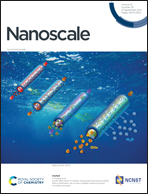Unusual interlayer coupling in layered Cu-based ternary chalcogenides CuMCh2 (M = Sb, Bi; Ch = S, Se)†
Abstract
Interlayer interactions play important roles in manipulating the electronic properties of layered semiconductors. One common mechanism is that the valence band maximum (VBM) and the conduction band minimum (CBM) in one layer couple to the VBM and CBM in another layer, respectively, resulting in the decrease of the band gap from the monolayer to the bilayer. Here we report an unusual interlayer coupling mechanism in layered Cu-based ternary chalcogenides CuMCh2 (M = Sb, Bi; Ch = S, Se) that the CBM in one layer strongly couples to the VBM in the other layer, leading to the band gap increase from the monolayer to the bilayer. Such an unusual interlayer interaction arises from the entangling between the electronic structures and the structures of CuMCh2 in which the cations M and anions Ch are alternatively arranged at the outmost part of each layer. Consequently, the M atom at the bottom of the upper layer is very close to the Ch atom at the top of the bottom layer, so that the orbitals of the M atom which dominate the CBM can strongly couple to the orbitals of the Ch atom which dominate the VBM, as demonstrated by the orbital hopping integrals obtained from the Wannier function analysis. The exceptional case of the unusual interlayer interaction revealed in this work enriches the diversity of the interlayer interactions in layered materials and is expected to exist in similar layered systems in which cations and anions are alternatively arranged at the outmost part of each layer.



 Please wait while we load your content...
Please wait while we load your content...